Bewitching scenery and an invigourating climate are the main features of Evritania prefecture. It is the mot thickly wooded, best-watered region in Greece. There are so many fir trees in Evritania that you think you’re in the midst of a magnificent endless forest, and in fact the region has been nicknamed “The Switzerland of Greece” for this reason.
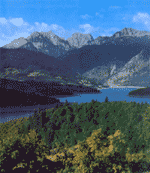 According to Homer, the first known inhabitants of northern Evritania were the Dolopes, who took part in the campaign against Troy. During the Byzantine era, the people of Evritania had the rare privileges of selfgovernment and tax exemption. For this reason the northern part of the district was also called “Agrafa”, (unwritten), because the residents were not listed in the Imperial tax registers. Its mountainous countryside also discouraged would-be counquerors.
According to Homer, the first known inhabitants of northern Evritania were the Dolopes, who took part in the campaign against Troy. During the Byzantine era, the people of Evritania had the rare privileges of selfgovernment and tax exemption. For this reason the northern part of the district was also called “Agrafa”, (unwritten), because the residents were not listed in the Imperial tax registers. Its mountainous countryside also discouraged would-be counquerors.
Karpenissi, capital of the prefecture, is located at the foothills of Mt. Timfristos, at an altitude of 960 meters.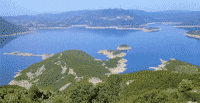 It most probably owes its name to the maple trees that abounded in the area in the 12th century (Carpen = maple tree, Carpenis = land of maple trees). The clear atmosphere, the dry healthy climate, the plane trees, fir and chestnut forests make Karpenissi an ideal place for winter and summer holidays. Among the town’s most characteristic features are the workshops that produce handmade brass bells for animals. The tinkling of the bells being tested is a picturesque, melodious welcome.
It most probably owes its name to the maple trees that abounded in the area in the 12th century (Carpen = maple tree, Carpenis = land of maple trees). The clear atmosphere, the dry healthy climate, the plane trees, fir and chestnut forests make Karpenissi an ideal place for winter and summer holidays. Among the town’s most characteristic features are the workshops that produce handmade brass bells for animals. The tinkling of the bells being tested is a picturesque, melodious welcome.
When eating at a Karpenissi taverna, try the feta cheese roasted in wax paper and the local sausages, and before you leave buy some goat butter and cheese, chestnuts and walnuts. You’ll also be impressed by the lovely handwooven fabrics made on traditional looms and the skilfully carved wooden objects on sale in the shops.
The church of Aghia Triada, the Gorgianades and the site of Kefalovrisso are among the places in the vicinity we recommend that you visit. Just 5 km. southwest of the capital, concluding one of the most beautiful drives, you come to Korishades, a village of well-preserved stone mansions. Here the GNTO has recently renovated and opened several traditional homes as guesthouses.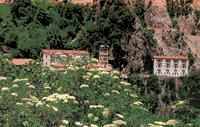 Not far away there are traces of ancient ruins, which have not yet been studied. Many scholars say that this was the ancient capital of Evritania, Oichalia.
Not far away there are traces of ancient ruins, which have not yet been studied. Many scholars say that this was the ancient capital of Evritania, Oichalia.
Next comes Mikro Horio, a marvellous place for a summer holiday, nestled in a small fir forest interspersed with apple, cherry and pear orchards. The view from here is magnificent. Megalo Horio lies nearby, situated in an equally lovely setting on the slopes of Kaliakouda, opposite Mt. Helidona. A little trip around the area will never be forgotten. At Klidi, a lush, majestic gorge, stands the Byzantine church of Aghios Athanassios.
After a drive through trees alongside the Trikerioti River, you arrive at the stately monastery of the Virgin Proussiotissa, which possesses a miracle – working icon said to have been painted by St. Luke. The monastery church was built in 1754 and is full of remakable icons, woodcarvings, sacred treasures and silver utensils. There is also a small museum in the monastery containing some personal mementoes of Karaiskakis, the Revolutionary hero. On the 15th and 23rd of August, the monastery becomes a place of pilgrimage, attracting the devout from allover Greece.
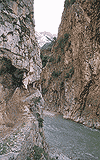 Opposite the monastery stands the chapel of Aghii Pantes, decorated with old icons. Above it loom Karaiskakis’ watch towers.
Opposite the monastery stands the chapel of Aghii Pantes, decorated with old icons. Above it loom Karaiskakis’ watch towers.
The village of Proussos, 800 meters above sea level, is not only picturesque; it has an interesting cave, the Black Cave or “Apokleistra” as it is also called. Believed to have been the site of an oracle, the cave has two entrances, one in the village, the other some distance away.
East of Karpenissi, the road from the verdant village of Aghios Nikolaos to Krikelo (1,120 m. alt.), which has a charming square with little cafes, passes through some especially beautiful, sprucefilled scenery. Near Krikelo is historic Kokalia. Even though the road is no longer paved after Krikelo, it is well worth making the effort to get to Domnitsa, a village crowded with little churches containing superb wooden icon screens and icons. The region is full of wildlife – hare, partridge, woodcock, and if you are in luck, you may even spot a wild boar.
West of Karpenissi lies Anatoliki (Eastern) Frangista with Ditiki (Western) Frangista 4 km further on, a lush area with a wonderful climate. Here the little church of the Saviour (Sotir) is worth a visit; built in 1725, has its walls covered with byzantine frescoes.
From Ditiki Frangista the road leads north to the village of Granitsa, whose folk museum is well known.
The more intrepid will want to venture as far as Agrafa, a remote village encircled by thick spruce forests. If you like fishing, the Agrafiotis River is full of trout. All these mountain villages are “buried” under snow for many months of the year.
Continuing south on the road from Ditiki Frangista, you reach the lake of Kremaston, the largest artifical lake in Greece, and from there on to the prefecture of Etoloakarnania.
 According to Homer, the first known inhabitants of northern Evritania were the Dolopes, who took part in the campaign against Troy. During the Byzantine era, the people of Evritania had the rare privileges of selfgovernment and tax exemption. For this reason the northern part of the district was also called “Agrafa”, (unwritten), because the residents were not listed in the Imperial tax registers. Its mountainous countryside also discouraged would-be counquerors.
According to Homer, the first known inhabitants of northern Evritania were the Dolopes, who took part in the campaign against Troy. During the Byzantine era, the people of Evritania had the rare privileges of selfgovernment and tax exemption. For this reason the northern part of the district was also called “Agrafa”, (unwritten), because the residents were not listed in the Imperial tax registers. Its mountainous countryside also discouraged would-be counquerors.Karpenissi, capital of the prefecture, is located at the foothills of Mt. Timfristos, at an altitude of 960 meters.
 It most probably owes its name to the maple trees that abounded in the area in the 12th century (Carpen = maple tree, Carpenis = land of maple trees). The clear atmosphere, the dry healthy climate, the plane trees, fir and chestnut forests make Karpenissi an ideal place for winter and summer holidays. Among the town’s most characteristic features are the workshops that produce handmade brass bells for animals. The tinkling of the bells being tested is a picturesque, melodious welcome.
It most probably owes its name to the maple trees that abounded in the area in the 12th century (Carpen = maple tree, Carpenis = land of maple trees). The clear atmosphere, the dry healthy climate, the plane trees, fir and chestnut forests make Karpenissi an ideal place for winter and summer holidays. Among the town’s most characteristic features are the workshops that produce handmade brass bells for animals. The tinkling of the bells being tested is a picturesque, melodious welcome.When eating at a Karpenissi taverna, try the feta cheese roasted in wax paper and the local sausages, and before you leave buy some goat butter and cheese, chestnuts and walnuts. You’ll also be impressed by the lovely handwooven fabrics made on traditional looms and the skilfully carved wooden objects on sale in the shops.
The church of Aghia Triada, the Gorgianades and the site of Kefalovrisso are among the places in the vicinity we recommend that you visit. Just 5 km. southwest of the capital, concluding one of the most beautiful drives, you come to Korishades, a village of well-preserved stone mansions. Here the GNTO has recently renovated and opened several traditional homes as guesthouses.
 Not far away there are traces of ancient ruins, which have not yet been studied. Many scholars say that this was the ancient capital of Evritania, Oichalia.
Not far away there are traces of ancient ruins, which have not yet been studied. Many scholars say that this was the ancient capital of Evritania, Oichalia.Next comes Mikro Horio, a marvellous place for a summer holiday, nestled in a small fir forest interspersed with apple, cherry and pear orchards. The view from here is magnificent. Megalo Horio lies nearby, situated in an equally lovely setting on the slopes of Kaliakouda, opposite Mt. Helidona. A little trip around the area will never be forgotten. At Klidi, a lush, majestic gorge, stands the Byzantine church of Aghios Athanassios.
After a drive through trees alongside the Trikerioti River, you arrive at the stately monastery of the Virgin Proussiotissa, which possesses a miracle – working icon said to have been painted by St. Luke. The monastery church was built in 1754 and is full of remakable icons, woodcarvings, sacred treasures and silver utensils. There is also a small museum in the monastery containing some personal mementoes of Karaiskakis, the Revolutionary hero. On the 15th and 23rd of August, the monastery becomes a place of pilgrimage, attracting the devout from allover Greece.
 Opposite the monastery stands the chapel of Aghii Pantes, decorated with old icons. Above it loom Karaiskakis’ watch towers.
Opposite the monastery stands the chapel of Aghii Pantes, decorated with old icons. Above it loom Karaiskakis’ watch towers.The village of Proussos, 800 meters above sea level, is not only picturesque; it has an interesting cave, the Black Cave or “Apokleistra” as it is also called. Believed to have been the site of an oracle, the cave has two entrances, one in the village, the other some distance away.
East of Karpenissi, the road from the verdant village of Aghios Nikolaos to Krikelo (1,120 m. alt.), which has a charming square with little cafes, passes through some especially beautiful, sprucefilled scenery. Near Krikelo is historic Kokalia. Even though the road is no longer paved after Krikelo, it is well worth making the effort to get to Domnitsa, a village crowded with little churches containing superb wooden icon screens and icons. The region is full of wildlife – hare, partridge, woodcock, and if you are in luck, you may even spot a wild boar.
West of Karpenissi lies Anatoliki (Eastern) Frangista with Ditiki (Western) Frangista 4 km further on, a lush area with a wonderful climate. Here the little church of the Saviour (Sotir) is worth a visit; built in 1725, has its walls covered with byzantine frescoes.
From Ditiki Frangista the road leads north to the village of Granitsa, whose folk museum is well known.
The more intrepid will want to venture as far as Agrafa, a remote village encircled by thick spruce forests. If you like fishing, the Agrafiotis River is full of trout. All these mountain villages are “buried” under snow for many months of the year.
Continuing south on the road from Ditiki Frangista, you reach the lake of Kremaston, the largest artifical lake in Greece, and from there on to the prefecture of Etoloakarnania.
Karpenissi
Karpenissi is the capital of Euritania, has built on the foothills of Mount Timfristos at an altitude of 960m/ 2438ft. 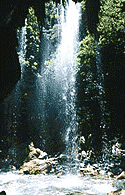
The spectacular countryside of Euritania enchants anyone who approaches it.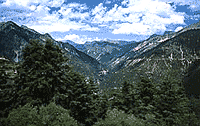 The healthy climate, the forested slopes, and the countless streams give the impression of heaven on Earth. Karpenissi, the district capital is built on the foothills of Mt. Timfristos, at an altitude of 960 metres. Among the plane, fir, and chestnut trees, Karpenissi is ideal for winter vacations and an alternative proposal for the summer, when it can be a springboard for excursions to nearby places, such as Gorgianades, Kefalovrisso, and the traditional village Korischades, whose stone houses are in good repair. A small fir tree forest and gardens with apple, cherry, and pear trees in Mikro Horio, On the slope of Kaliakouda, opposite Helidona, is Megalo Horio. Proussos is at an altitude of 800 metres and east of Karpenissi is Krikelo close to Kokalia a historic location among the fir trees just before Domnitsa itself a village of many chapels located in enchanting surroundings.
The healthy climate, the forested slopes, and the countless streams give the impression of heaven on Earth. Karpenissi, the district capital is built on the foothills of Mt. Timfristos, at an altitude of 960 metres. Among the plane, fir, and chestnut trees, Karpenissi is ideal for winter vacations and an alternative proposal for the summer, when it can be a springboard for excursions to nearby places, such as Gorgianades, Kefalovrisso, and the traditional village Korischades, whose stone houses are in good repair. A small fir tree forest and gardens with apple, cherry, and pear trees in Mikro Horio, On the slope of Kaliakouda, opposite Helidona, is Megalo Horio. Proussos is at an altitude of 800 metres and east of Karpenissi is Krikelo close to Kokalia a historic location among the fir trees just before Domnitsa itself a village of many chapels located in enchanting surroundings.
West of Karpenissi are Fragista, Granitsa, and Agrafa, lovely mountain villages, which disappear in winter under a thick blanket of snow.

The spectacular countryside of Euritania enchants anyone who approaches it.
 The healthy climate, the forested slopes, and the countless streams give the impression of heaven on Earth. Karpenissi, the district capital is built on the foothills of Mt. Timfristos, at an altitude of 960 metres. Among the plane, fir, and chestnut trees, Karpenissi is ideal for winter vacations and an alternative proposal for the summer, when it can be a springboard for excursions to nearby places, such as Gorgianades, Kefalovrisso, and the traditional village Korischades, whose stone houses are in good repair. A small fir tree forest and gardens with apple, cherry, and pear trees in Mikro Horio, On the slope of Kaliakouda, opposite Helidona, is Megalo Horio. Proussos is at an altitude of 800 metres and east of Karpenissi is Krikelo close to Kokalia a historic location among the fir trees just before Domnitsa itself a village of many chapels located in enchanting surroundings.
The healthy climate, the forested slopes, and the countless streams give the impression of heaven on Earth. Karpenissi, the district capital is built on the foothills of Mt. Timfristos, at an altitude of 960 metres. Among the plane, fir, and chestnut trees, Karpenissi is ideal for winter vacations and an alternative proposal for the summer, when it can be a springboard for excursions to nearby places, such as Gorgianades, Kefalovrisso, and the traditional village Korischades, whose stone houses are in good repair. A small fir tree forest and gardens with apple, cherry, and pear trees in Mikro Horio, On the slope of Kaliakouda, opposite Helidona, is Megalo Horio. Proussos is at an altitude of 800 metres and east of Karpenissi is Krikelo close to Kokalia a historic location among the fir trees just before Domnitsa itself a village of many chapels located in enchanting surroundings.West of Karpenissi are Fragista, Granitsa, and Agrafa, lovely mountain villages, which disappear in winter under a thick blanket of snow.

